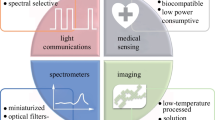Abstract
The present paper is the sequel to a previous report. In this paper, electron transport in various selenium-based amorphous xerographic photoreceptors is described. As before, measurements were carried out using xerographic time-of-flight (XTOF) and conventional time-of-flight (TOF) experiments. From the observed flight time the electron drift mobilityμ e was deduced. Transient photocurrent signals were also recorded at low fields to determine the decay time constant. For a given composition, the sample thickness, light intensity, substrate material and top contacts (in TOF) were varied to investigate whether the observed decay time constantτ e is a meaningful bulk parameter as in the case of hole transport. Detailed results will be presented to show that the interpretation ofτ e is complicated. The more plausible explanation for the observed decay is the presence of a uniform distribution of positive space charge in the bulk.μ e andτ e were also measured as a function of composition and applied field. Experimental data suggest that electron transport is shallow trap-controlled. Light doping of selenium with arsenic or tellurium creates shallow traps and hence reducedμ e. The field dependence of electron mobility is in the formμ e ∝E n whereE is the applied field andn is a constant less than unity. No electron response can be detected in chlorine-doped Se-As or Se-Te alloys.
Similar content being viewed by others
References
S. M. Vaezi-Nejad andC. Juhasz,J. Mater. Sci. in press.
S. M. Vaezi-Nejad,Int. J. Electronics 62 (3) (1987) 361.
S. M. Vaezi-Nejad andC. Juhasz,Thin Solid Films 148 (1987) 251.
K. Tomura andH. Maekawa,Jap. J. Appl. Phys. 16(4) (1977) 655.
M. Abkowitz, F. Jansen andS. Robinett,J. Vac. Sci. Tech. 20 (1982) 875.
M. Abkowitz andF. Jansen,J. Non-Cryst. Solids 59/60 (1983) 953.
D. M. Pai, in “Amorphous and Liquid Semiconductors”, edited by J. Stuke and W. Brenig (Taylor and Francis, London, 1974) p. 355.
M. Okunda,et al,J. Non-Cryst. Solids 59/60 (1983) 1035.
E. Montrimas andB. Petritis,ibid. 15 (1974) 96.
Author information
Authors and Affiliations
Rights and permissions
About this article
Cite this article
Vaezi-Nejad, S.M., Juhasz, C. Electron transport in selenium-based amorphous xerographic photoreceptors. J Mater Sci 24, 471–476 (1989). https://doi.org/10.1007/BF01107429
Received:
Accepted:
Issue Date:
DOI: https://doi.org/10.1007/BF01107429




